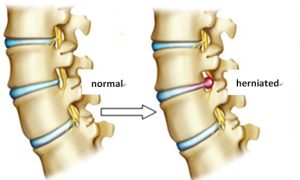
Essential information for those experiencing herniated discs in the lower back
This injury occurs when a portion of the spongy, shock absorbing tissue between the vertebrae becomes displaced. Most people will remember an initial moment that caused their pain. It is through doing activities like lifting, bending or twisting, that this injury may commonly occur. Middle aged individuals are at a higher risk compared to young adults and elderly people. Majority of disc herniations occur between the L4-L5 or L5-S1 vertebrae.
Pain is often described as burning or searing, and in some cases can cause a radiating sensation down the thigh or lower leg. Moreover, associated muscle weakness and changes to skin sensation can occur, caused by nerve compression, if the condition is severe enough. Movements like bending forward or straightening the knee while sitting can increase the symptoms.
Current Research
Below is a summary of current research and knowledge known about the outcomes of this type of injury.
- Approximately 75% of disc herniations heal within 6 months, often sooner.
 People with no back pain and no symptoms can show evidence of disc herniation in an MRI scan. Therefore, a herniated disc is not always going to cause you pain, or may not be the reason for pain. It’s important to consider that other musculoskeletal injuries may present with similar symptoms.
People with no back pain and no symptoms can show evidence of disc herniation in an MRI scan. Therefore, a herniated disc is not always going to cause you pain, or may not be the reason for pain. It’s important to consider that other musculoskeletal injuries may present with similar symptoms.- Active individuals are more likely to attain better results in recovery, compared to sedentary individuals. This is because discs have poor blood flow and love movement. They rely on the pressure and load from our moving bodies to get nutrients in and out of the injured tissue. Therefore, you should rarely stop all activity after a disc injury. A slow and progressive return to activity is essential and this can start right away.
Types of Treatment
- Physiotherapy is considered the primary conservative treatment for patients with disc herniation. Movement, strength and maintaining a healthy lifestyle are the keys to healing this injury both initially and in the long term.
- An injection into the lumbar spine can help control pain and inflammation if physiotherapy treatment is not progressing. This may help relieve symptoms enough to allow for exercise and movement to be performed. Although, it should be taken into account that this procedure does have mixed results.
- Surgery is only recommended for those with severe neurological symptoms or as a last option for chronic cases. However, surgery does not always guarantee a good result. In most cases, conservative treatment should be trialed for several months before opting for a surgical option.
The most important factor is to restore normal body function through strengthening the right muscle groups. Additionally, developing movement patterns will help unload the injured disc. As a result, this will reduce the forces going through the disc and allow a return to daily activities in a pain free manner.
If you’re looking to relieve symptoms and strengthen your muscles, BOOK IN to see one of our physiotherapists today.


